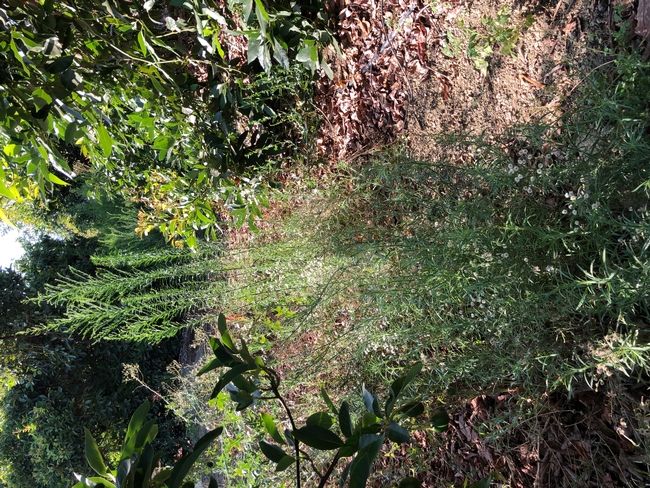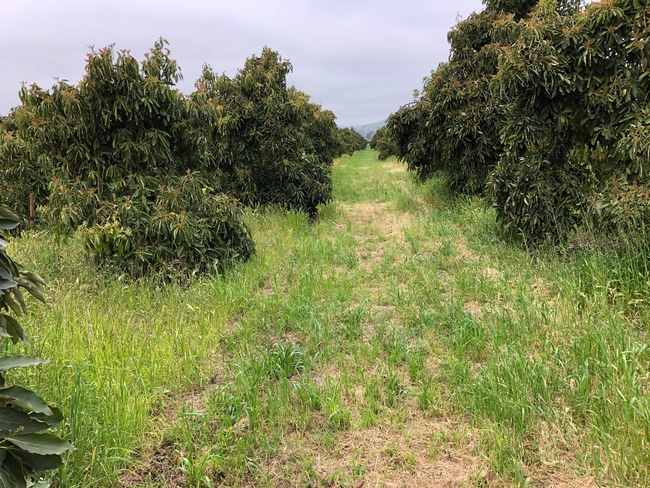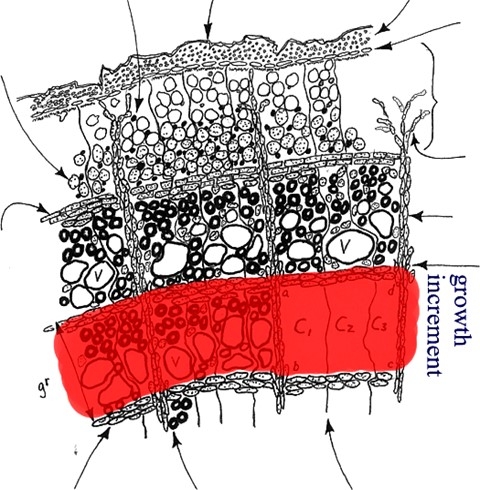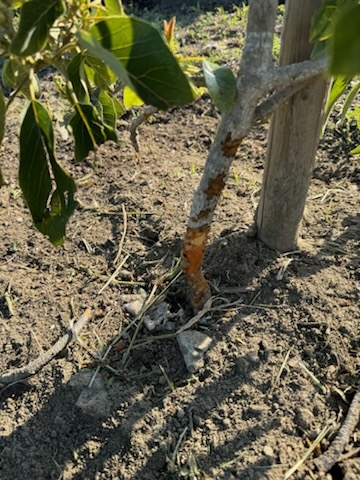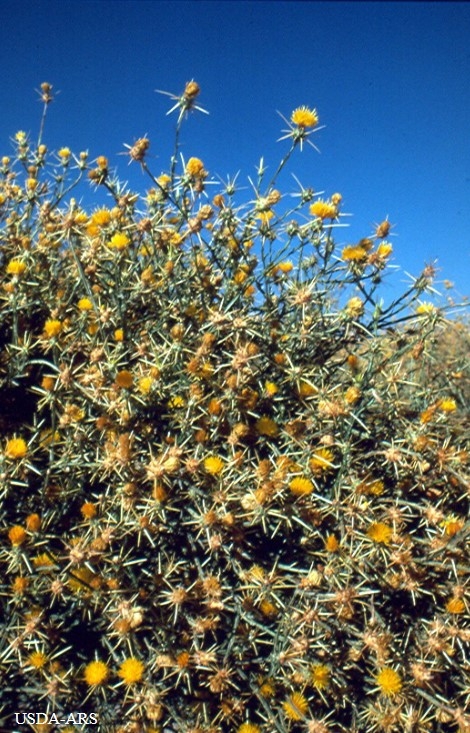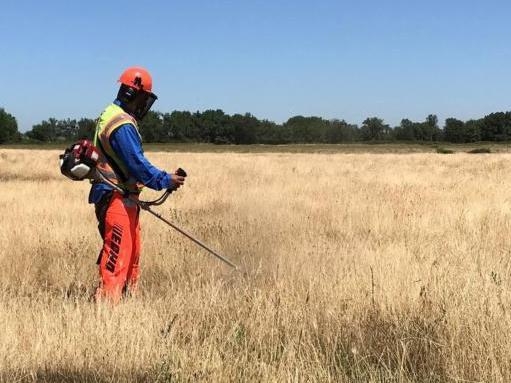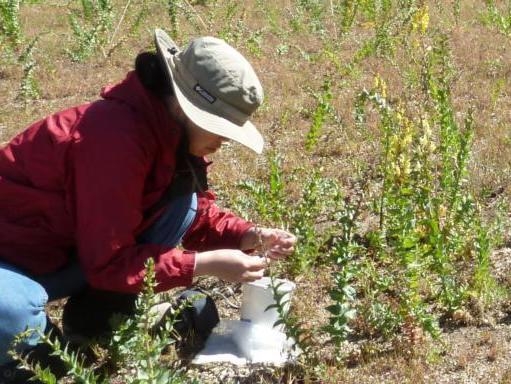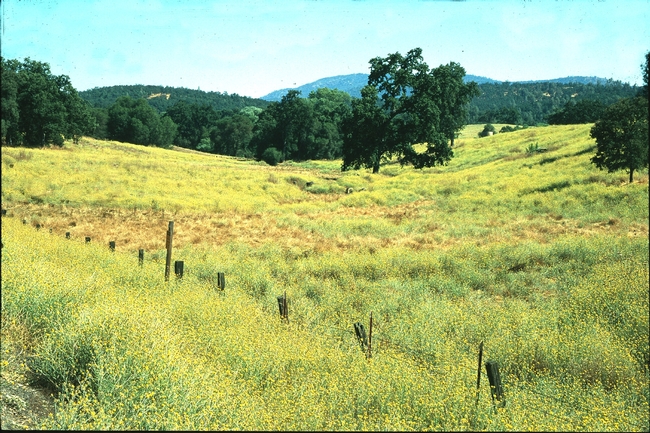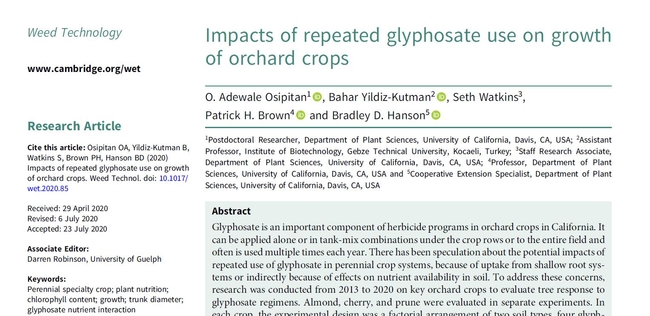Published on: May 26, 2024
Sterile Pollen Technique Shows Promise for Palmer Amaranth Weed Control
Newly published research provides a novel and sustainable weed-management strategy
WESTMINSTER, Colorado – 22 May2024 – Recently published research in the journal Weed Science shows that a sterilization technique commonly used to control insect pests can be modified to control weeds that require pollination to reproduce. More specifically, the researchers determined that employing a sterile pollen technique (SPT) could effectively disrupt Palmer amaranth (Amaranthus palmeri S.) reproduction.
Palmer amaranth remains among the most detrimental weeds in North American agriculture, and its resistance to several herbicide groups makes its control a serious challenge. Yet, researchers in this study were able to find a promising new control method for Palmer amaranth and possibly for many other difficult-to-control weeds.
“Our results indicate that SPT, using irradiated pollen, can be a valuable approach for reducing weed-seed production,” says Mohsen B. Mesgaran, Ph.D., a plant sciences assistant professor at the University of California Davis, and the article's corresponding author. “SPT also holds potential for broad-spectrum weed control by mixing sterile pollen from multiple weed species in a single application.”
Additionally, the researchers found that SPT shows promise for managing troublesome herbicide-resistant weeds that have survived in-season control efforts.“We observed the greatest reduction in seed set when irradiated pollen was introduced to the stigma through artificial pollination prior to open pollination,” notes Mesgaran. “It appears that irradiated pollen exerts a preventive effect on naturally occurring pollen that arrives later.”
While the researchers determined that a dose of 300 units of ionizing radiation (Gy) strikes the optimal balance to achieve both efficient Palmer amaranth pollination and seed sterility, challenges still remain. For example, irradiated pollen is currently less competitive than naturally occurring pollen. Thus, field managers may need to employ additional measures to successfully control Palmer amaranth with SPT, such as dispersing irradiated pollen in the field before male anthesis and releasing it multiple times.
More information about SPT and Palmer amaranth control can be found in the article (by Wenzhuo Wu and Mohsen B. Mesgaran), “Exploring sterile pollen technique as a novel tool for management of Palmer amaranth (Amaranthus palmeri).” The research is featured in Volume 72, Issue 3 of Weed Science, a Weed Science Society of America journal, published online by Cambridge University Press.
Original source: Weed Science Society of America (https://wssa.net/2024/05/sterile-pollen-technique-shows-promise-for-palmer-amaranth-weed-control/)
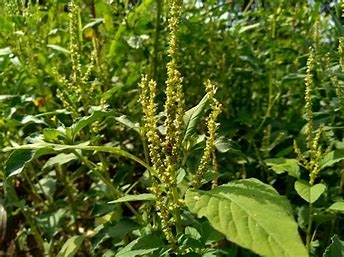
palmer amaranth
Posted on
Friday, June 21, 2024 at
7:13 AM
Focus Area Tags: Agriculture
With all the rain last year, even extending into August and now with the rains since December there is a lot of natural ground cover growing, When it gets out of hand, we call it weedy. It might still serve the purpose of protecting the ground from erosion, but it can become an impenetrable mess and if allowed to go into summer, a major fire hazard. In the case of some young orchard, the malva and mustard is bigger than the trees themselves. Getting control of them before they get woody and go to seed is easier earlier than later. So it's time to do something about them if you haven't done so already.
A common practice on flat ground is to mow the middles and then weed whack/whip the tree row up to and around the tree trunk. In the case of trees that have their canopies down to the ground or near the ground or that have created a thick leaf mulch, there's not usually much weedy growth near the trunk. Then weed whacking around the canopy is not much of a problem. If on a slope like most avocados, it's a big, expensive, laborious, hot, sweaty, arduous process of weed whacking. Just waiting long enough for the leaf mulch to create a barrier to weed growth and for the canopies to grow out to rob the sun from the surface undergrowth.
In young trees without a large canopy, it can be a really difficult process of getting those weeds near the trunk. Care must be taken to avoid damage to the trunk. In a couple of recent examples, weed whacking got right up and on the trunks and significant damage was done to the trees. When a wound occurs in any tree, a process kicks in to generate tissue to cover the wound, much like what happens with humans and wound cuts. There's a scar left, but it heals over. If the wound is too large, many trees cant cover the woody tissue fast enough. The wood beneath the cambium ( the green tissue below the bark) is prone to fungal infection and eventually the fungus eats away at the interior of the tree. If the wound is large enough and girdles the tree, all the nutrients from the leaves feeding the roots is cut off. The photosynthate sugars that keep the roots functioning, and the roots stop doing what roots do. This is absolutely true is citrus and most other orchard tree crops. But not avocado.
When making a cross section of most trees, it's possible to see the growth rings – the growth increments that appear each year. The tree starts and stops growth each year and it's possible to clearly identified in what year there was more or less growth. In long lived trees like redwood, it's possible to identify years when certain events happened – the year of Lincoln's Gettysburg Address, for example. This growth habit is called ring porous.
In the case of avocado, it has a growth habit called diffuse porous. There is growth throughout the year and the rings are nor clearly delineated, if at all. It's because of this possible active growth occurring, that the avocado can often cover over damage that is quite extensive. After a fire, given time, mature avocado trees can summon up energy to recover to a great extent. It's not so true of young trees, however. Avocados still have a greater regenerative capacity than a lemon tree, and if the damage is to just one side of the tree, there's a very good chance of recovery.
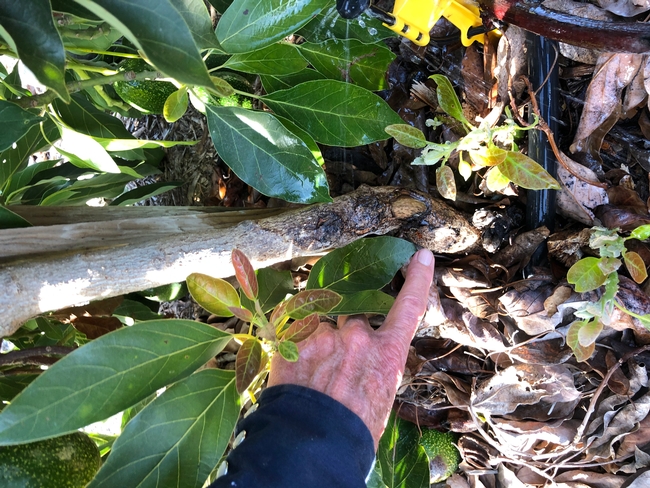
But these young tree are severely impaired. They do have a chance of recovery, but the damage is extensive and the trunk is fully girdled. Only time will tell if they do recover. If the tree were only a year old, it would be a good idea to pull them and start over. But a number of these trees are three years old and have had a lot of investment in them besides their initial nursery cost – pruning, weeding, irrigation, fertilization, etc. It is heart breaking to see damage like this after so much attention has been paid to them.
And the best thing is to let the tree recover on its own. Use of pruning paint actually impairs tissue regeneration. The grower asked if a kaolin protectant like Surround might be used to provide some sun protection. Since that breathes, it might be a good idea. It might also be a good idea to apply some trunk wraps. These were taken off in order to prevent earwig and snail harbor which can cause significant damage to young trees. But they also provide protection from overly aggressive weed whackers. It is always a compromise when making these decisions.
Posted on
Thursday, March 28, 2024 at
4:52 PM
Focus Area Tags: Agriculture
This manual provides comprehensive descriptions of 21 commonly used non-chemical weed control techniques and of biological control agents for 18 weed species/species groups that will help you as a practitioner treat weeds more effectively.
Authors of each chapter have compiled research and on-the-ground knowledge of subject experts on tools and methods of application, as well as on efficacy of techniques under various environmental conditions and across different classes of invasive plants. Environmental, cultural, and human safety risks are also highlighted to help support safe and effective use of techniques. This manual is designed to be a go-to resource for practitioners that are either complementing their weed control work with non-chemical techniques or are exclusively restricted to not using herbicides. Individual BMPs will be incorporated into an online decision support tool still in development.
There is a section on biological control agents. Approved biological control agents can be distributed within California without a permit, and most can also be distributed across state lines (based on prior permits). The main exception is when an agent that has been approved by USDA-APHIS has not been approved for California (e.g. Aceria malherbae for field bindweed) or whose permit was rescinded (Diorhabda spp. for saltcedar).
The best source of information is:
Smith, L., Pitcairn, M.J., Moran, P.J. 2020. Biological Control, pp. 193-291. In: Best Management Practices for Non-Chemical Weed Control. Report to the California Department of Pesticide Regulation under grant number 18-PML-G002. California Invasive Plant Council. 291 p. 115 p.
https://www.cal-ipc.org/resources/library/publications/non-chem/
This is a free pdf document that has chapters on each target weed that has approved biological control agents in California.
Regarding yellow star thistle, 6 agents have been released in California and were widely distributed. In general, only a few of these are abundant enough to have impact, and some of them do better than others in specific habitats. For example, the hairy weevil (Eustenopus villosus) is more abundant in the Sierra Foothills and Coastal Hills and the false peacock fly (Chaetorellia succinea) is more abundant in the Central Valley. However, it is possible that they are not necessarily established at your particular site. It's recommended to first look to see what is there already. If insects are present, then it is not worth releasing more, but you may be able to adjust your integrated management plan to take advantage of their presence (see recommendations in the above BMP document. The hairy weevil and false peacock fly are the most abundant species in California. The newly-approved rosette weevil (Ceratapion basicorne) is being multiplied by CDFA, and is not yet widely available.
Best Management Practices for Non-Chemical Weed Control
This manual is available as a free download. Click here for a PDF of BMP for Non-Chemical Weed Control. (291 pp., 21.5 MB)
- Contents:
- Removing Whole Plants (5 techniques)
- Controlling Plants by Cutting (6 techniques)
- Controlling Plants in Place (3 techniques)
- Covering Plants with Sheet Barriers (3 techniques)
- Controlling Plants at a Plant Community Scale (4 techniques)
- Biological Control (general introduction and descriptions of agents for 18 weed species/species groups)
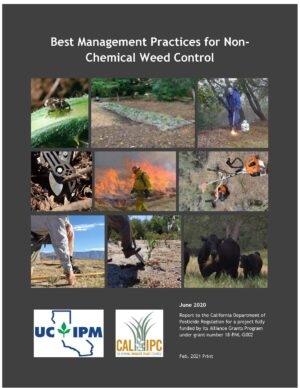
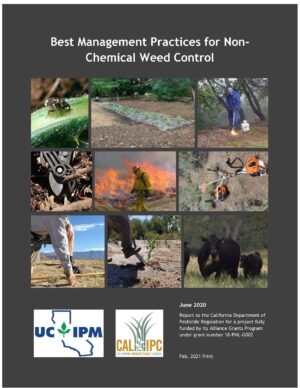
DPR Non-Chemical BMP Report Cover-300x388
Posted on
Monday, August 7, 2023 at
8:55 AM
Focus Area Tags: Agriculture
California has abundant wildlands — forests, rangeland, open areas, wildlife refuges and national, state, and local parks — that need protection from invasive plants. Invasive plants affect all Californians by increasing wildfire potential; reducing water resources; accelerating erosion and flooding; threatening wildlife; degrading range, crop and timberland; and diminishing outdoor recreation opportunities. According to the California Invasive Plant Council (Cal-IPC), more than 200 identified plant species harm California's wildlands.
Cal-IPC and the University of California Statewide Integrated Pest Management Program (UC IPM), with funding from the California Department of Pesticide Regulation (DPR) Alliance Grants Program, developed two resources that provide land managers access to the latest information on non-herbicide practices for managing weeds in wildlands. Best Management Practices for Non-Chemical Weed Control is a free downloadable manual. The same information has been incorporated into an interactive online tool called WeedCUT (Weed Control User Tool: weedcut.ipm.ucanr.edu).
"We anticipate WeedCUT will increase the use of more mechanical, physical, or biological practices, and potentially result in the reduction of herbicides used to manage wildland invasive weeds," said area IPM advisor emeritus Cheryl Wilen. "Best Management Practices for Non-Chemical Weed Control and WeedCUT were developed so land managers can become more knowledgeable and skilled in the use of non-herbicide methods as part of an IPM program.”
Knapweed control with a brush cutter. (Photo: Dawn Cunningham)
Best Management Practices for Non-Chemical Weed Control provides comprehensive descriptions of 21 commonly used non-herbicide weed control techniques and biological control agents for 18 invasive plants. Each chapter is the synthesis of research and on-the-ground knowledge from practitioners about non-herbicide methods. The chapters describe how a technique is best applied, the types of invasive plants and environmental conditions where it is most effective, and what its shortfalls might be. Environmental, cultural, and human safety risks are highlighted to help support the safe and effective use of these methods.
WeedCUT is the online version and can be used to learn about the different non-herbicide management methods, including the section on biological control. To filter through the database and learn which management practice to consider for a particular site and invasive plant type, a simple interface allows users to pick characteristics that describe their site and invasive plant problem. The tool then filters through the database to display the practices ranked by efficacy (excellent, good, fair, poor or ineffective). As in the manual, use of the technique and potential hazards are covered.
Best Management Practices for Non-Chemical Weed Control and WeedCUT are designed to be the go-to resources for practitioners that complement their conventional weed management work with non-herbicide techniques or are restricted in their use of herbicides. Both resources will help practitioners manage weeds more effectively.
Person releasing weevils for the biological control of Dalmatian toadflax. (Photo: Lincoln Smith USDA-ARS)
“Many experts in the field have contributed to create the manual and WeedCUT. It has been exciting to see these techniques described and reviewed so carefully. We're looking forward to seeing land managers, as well as all folks fighting weeds, incorporating the information from the manual and WeedCUT into their work,” said Jutta Burger, science program director and project lead with Cal-IPC.
While the manual and tool focus on non-herbicide methods, the hope is future funding can be found to continue the work and integrate herbicide options online.
"Land managers typically use both herbicide and non-herbicide methods, alone and in combination, to manage invasive plants in wildlands," said UC Cooperative Extension advisor and UC IPM-affiliated advisor Tom Getts. "A tool that combined both herbicide and non-herbicide methods would guide land managers to determine the most effective overall management program for their particular site."
Yellow starthistle is an invasive rangeland weed. (Photo: J. M. DiTomaso)
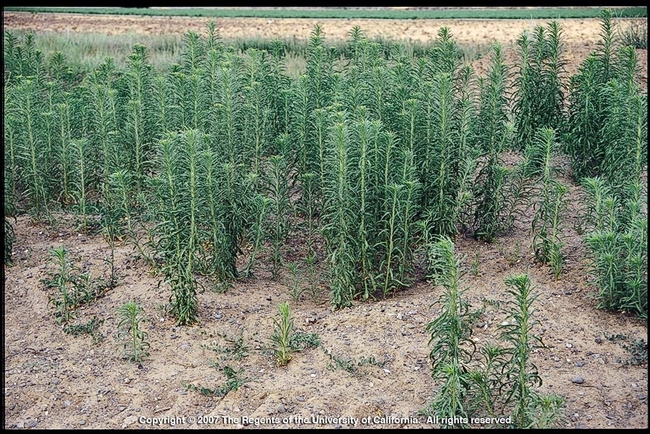
horseweed mature
Posted on
Wednesday, July 14, 2021 at
8:12 AM
- Author:
Tunyalee A. Martin, Jutta Burger, Cheryl A. Wilen, Thomas Getts
Focus Area Tags: Agriculture
Article also published in California Weed Science Society Journal (March 2021 issue)
-Brad
Glyphosate is one of the most commonly used herbicides in orchard crops in California both in terms of treated acres and amount of active ingredient applied. Weed managers are generally familiar with the attributes of glyphosate as a postemergence herbicide. Duke and Powles (2008) published an article in Pest Management Science entitled “Glyphosate: a once-in-a-century-herbicide”. Suffice to say, it's a pretty useful herbicide, if that's your thing. It has also been the subject of several controversies in the past couple of decades.
One of those controversies was a source of frequent extension questions from California farmers and Pest Control Advisors about 10 years ago. In the late 2000's there were several researcher articles from work done in glyphosate-tolerant soybeans that suggested there might be some nontarget impacts of glyphosate on crop nutrient status, plant disease interaction, and microbial community effects. In California tree crops concern generally focused around whether glyphosate in the soil could chelate micronutrients and lead to nutrient deficiencies and/or if repeated use could cause enough glyphosate to accumulate in soil and have direct impacts on the trees.
In a 2012 review article on the impacts of glyphosate in the soil environment, Duke et al. suggested that “significant effects of glyphosate on soil mineral content is unlikely” and there is no clear negative trend in orchard productivity data in California even after decades of glyphosate use. However, because this was a concern for the California orchard crop industries, we conducted a long-term research project from 2013 to 2020 to help address the issue in representative orchard crops.
If you're REALLY interested, the full report was published in summer 2020 as an open-access article in the journal Weed Technology which can be accessed HERE.
If you're only a LITTLE interested, here is the essence of the project conduct at the UC Davis Plant Sciences Field Facility in Davis, CA:
- Crops (three crops were considered separate experiments):
- Almond (Nonpareil on Lovell)
- Prune (Improved French on Lovell)
- Cherry (Coral on Emla-Colt)
- Planting site:
- At planting, all tree sites were excavated with a 36-inch diameter augur to a 2-ft depth
- Half were refilled with the native silty clay loam soil
- Half were refilled with Delhi sandy loam
- Glyphosate treatments:
- From 2014 to 2019, treatments were applied 3 times per season (~between Apr-Nov)
- Rates were 0, 1, 2, or 4 lb ae/A equivalents (Roundup PowerMAX plus ammonium sulfate). Applied to an area of about 6x6 ft around each tree
- In 2014, trunks were protected with cartons, but no trunk protection in 2015-19
- Drench
- In the first two years of treatment (2014 and 2015) there was a split-plot factor in which half of the trees had a small berm built up around the base of the tree and were “drenched” with water to simulate a 1-inch irrigation immediately after each application (intended to increase leaching into the relatively small tree root zone and crown area).
- Evaluations
- In the first year of treatment (2014) leaf samples were collected 14 days after each glyphosate application and assayed for shikimate accumulation (which would indicate direct herbicidal effects of glyphosate).
- In the first two years of treatment, relative chlorophyll content was measured in leaves from each tree 30 days after each glyphosate application (which could indicate either direct glyphosate effects or indirect effects of micronutrient limitations).
- Trunk diameter measurements were made before the first application in 2014 and during the winter after each subsequent season to evaluate relative tree growth.
- After the 6th year of treatment, leaf samples were collected in the fall from each tree but combined over soil type and drench subplots. The nutrient status of these leaf samples was determined by the UC Davis Analytical Lab using appropriate techniques.
- So, to recap, the worst case scenario had:
- Very coarse soil in the planting site of bare root almond, cherry, and prune nursery trees.
- In the first two years, some plots had a simulated acre-inch of irrigation immediately following each glyphosate application.
- The highest rate treatment of 4 lb ae/A glyphosate applied 18 times over a six year period. That's 114 fl oz/A of Roundup PowerMAX at each application. Over the course of the experiment that's 72 lb ae/A glyphosate or 16 gallons of Roundup PowerMAX. It's a lot!
- Results:
- Shikimate levels were similar among treated and non-treated trees with no clear dose-response or soil-related parameters. This suggests little or no direct effect of glyphosate on these tree crops via root uptake even at fairly extreme rates over multiple years.
- Chlorophyll content mostly indicated no differences among treatments. Where there were statistically significant main effects or interactions, there was no consistent pattern with regard to glyphosate rate, coarse soils, and post-treatment drench, which suggests they may be due to random variation or experimental artifacts.
- Leaf nutrient analysis after 6 years of treatment did not provide evidence of negative impacts on crop nutrient status.
- Trunk diameter increase over six growing seasons was not negatively impacted by glyphosate treatments (Figure).
- Observationally, over the six year period, there was no evidence of treatment-related trunk cankers, trunk or limb malformations or unusual die-back.
Scientists will always remind you that you “can't prove a negative”, and that remains true. However, we think these data suggest that it is probably not easy or common for almond, cherry, or prunes to be negatively impacted by glyphosate residues in the soil either due to direct herbicide effects or to micronutrient deficiencies.
Acknowledgments:
This work was initially supported by the Almond Board of California, the California Dried Plum Board and with nursery stock provided by Sierra Gold Nurseries. Over time, the experiments were maintained with general program support from the crop protection industry, orchard commodity groups, and agricultural input suppliers. We gratefully thank our colleagues who contributed to this long-term project along the way.
References:
Duke SO, Powles SB (2008) Mini-review. Glyphosate: a once-in-a-century herbicide. Pest Manag Sci 64:319–325
Duke SO, Lydon J, Koskinen WC, Moorman TB, Chaney RL, Hammerschmidt R (2012) Glyphosate effects on plant mineral nutrition, crop rhizosphere microbiota, and plant disease in glyphosate-resistant crops. J Agric Food Chem 60:10375–10397
Osipitan OA, Yildiz-Kutman B, Watkins S, Brown PH, Hanson BD (2020). Impacts of repeated glyphosate use on growth of orchard crops. Weed Technol. doi: 10.1017/wet.2020.85 (available at: https://www.cambridge.org/core/journals/weed-technology/article/impacts-of-repeated-glyphosate-use-on-growth-of-orchard-crops/26697F334626A587765C75C2B0F76A3D)
This blog originally appeard in the UC Weed Science Blog
https://ucanr.edu/blogs/blogcore/postdetail.cfm?postnum=46316
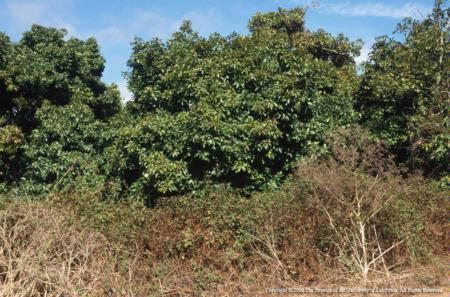
weeds bordering avocado orchard
Posted on
Friday, April 30, 2021 at
7:45 AM
- Author:
Brad Hanson and O. Adewale Osipitan
Focus Area Tags: Agriculture




